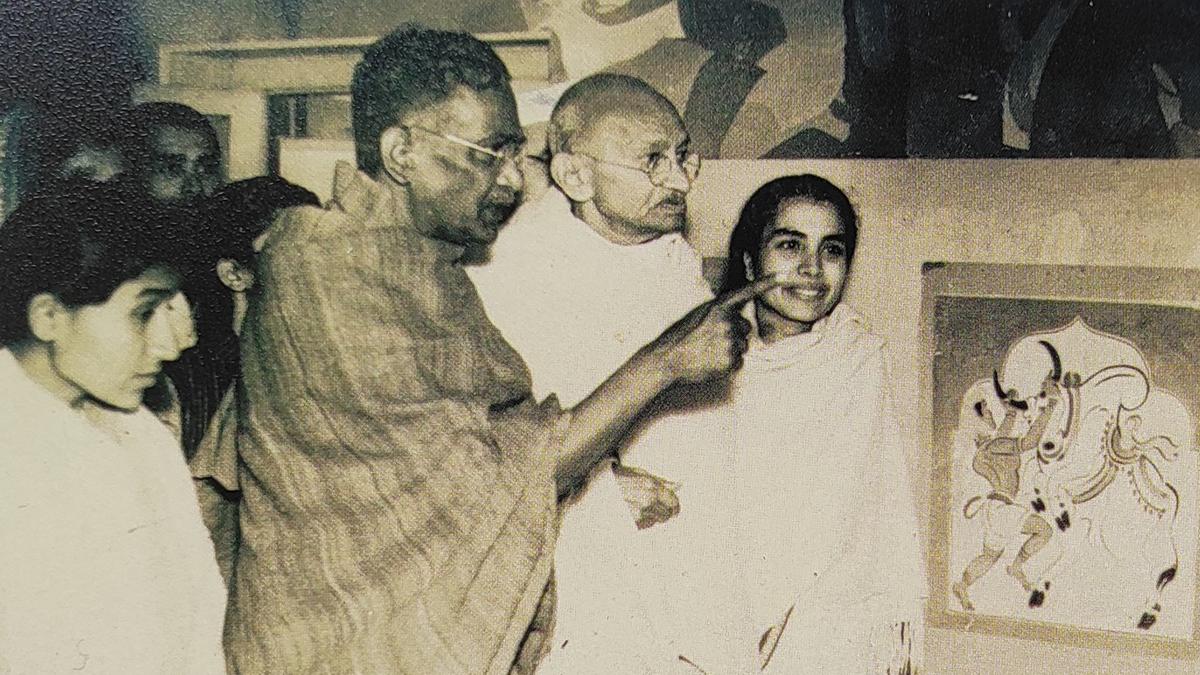Revisiting Haripura Panels: Nandalal Bose's Brush Strokes of Indian History
History Indian HistoryPosted by NewAdmin on 2025-02-11 09:05:07 |
Share: Facebook | Twitter | Whatsapp | Linkedin Visits: 66

Nandalal Bose: A Visionary Artist
Mahatma Gandhi once referred to Nandalal Bose as a “man who could make art out of anything.” This description reflects Bose’s extraordinary ability to capture the essence of India’s cultural and political landscape through his art. The National Gallery of Modern Art (NGMA) in Delhi proudly houses over 6,800 paintings by Bose, showcasing his remarkable talent. Perhaps most notably, Bose made a significant contribution to the Indian Constitution, with 22 hand-drawn illustrations adorning its first manuscript, a testament to his artistic mastery and deep commitment to India's freedom struggle.
The Haripura Panels: A Legacy in Art
In 1938, Mahatma Gandhi commissioned Nandalal Bose to create the iconic Haripura panels for the Haripura Congress. The project comprised 400 panels that beautifully depicted India’s rural life, weaving a narrative that resonated with the spirit of the times. These panels were not only works of art but also served as powerful visual statements of Indian identity and the country's aspirations for independence. Today, 77 of these panels are on display at the National Gallery of Modern Art, Bengaluru, offering viewers a glimpse into the rich cultural heritage that Bose so masterfully captured.
Bose’s National Treasures
Nandalal Bose’s works, including the Haripura panels, have been recognized as National Treasures of India. His art went beyond mere aesthetics; it was a reflection of India's socio-political landscape during the freedom struggle. By intertwining themes of rural India and the spirit of nationalism, his paintings became a form of visual resistance against colonial rule. The Haripura panels stand as an emblem of this creative fusion, immortalizing a moment in history that was pivotal in shaping the national consciousness.
A Journey Through Time
The current display of the Haripura panels in Bengaluru provides an opportunity to immerse oneself in the vivid brushstrokes of India’s past. Nandalal Bose’s art continues to inspire generations, offering not just historical context but also a profound understanding of the struggles and values that shaped modern India. The panels, along with his other works, remind us of the enduring power of art in documenting history, and how it can serve as both a reflection of the times and a means to shape future generations’ understanding of their heritage.
Search
Categories
- Sports
- Business
- History
- Politics
- International
- Science & Technology
- Social Issues
- Disaster Management
- Current Affairs
- Education
- Startup Business
- Startup News
- Awards
- Community Services
- Fundraising Events
- Volunteer Services
- Health Initiatives
- Innovations and Initiatives
- In News
- dummybanners
- Awards
- Partners
- Products
- Press Releases
- News
- Fast Check
- South
- సినిమా
- Gallery
- Sunday Chronicle
- Hyderabad Chronicle
- లైఫ్ స్టైల్
- National
- క్రైం
- ట్రెండింగ్
- జాబ్స్
- అంతర్జాతీయo
- బిజినెస్
- రాజకీయం
- బిజినెస్
- సంపాదకీయం
- నవ్య
- చిత్ర జ్యోతి
- క్రీడలు
- జాతీయం
- తెలంగాణ
- తాజా వార్తలు
- మన పార్టీ
- మన నాయకత్వం
- మన విజయాలు
- డౌన్లోడ్స్
- మీడియా వనరులు
- కార్యకర్తలు
- North East Skill Center News
- Government Schemes
- Entrepreneurship Support
- Employment Opportunities
- Skill Training Programs
- Departments
- Investments
- Initiatives
- Resources
- Telangana IT Parks
- Events & Jobs
- Press Releases
- News
- Airport News
- Newtons Laws of Motion
- Karbonn in Business
- Investments in Karbonn
- Company quarterly sales
- Markets
- Auto News
- Industry
- Money
- Advertisements
- Stock target
- Company Updates
- Stock Market
- Company Sales
- Staffing and HR
- Constituency Assembly
- General News
- Srikalahasti Temple
- Bojjala Sudhir Reddy
- Technology & Innovation
- Sports
- Business
- Products
- Industries
- Services & Trainings
- Tools & Resources
- Technology Integration
- Drug Seizures & Arrests
- Telangana Narcotics
- Law & Enforcement
- Rehabilitation
- Nationwide Drug Policing
- Nigeria Seizures
- Global Operations
- Drug Awareness
- Drug Enforcement Tech
- NCB Drug Seizures
- Judicial Crackdown
- India's Surveillance Tools
- Cross-Border Links
- Women Safety
- Cyber Crimes
- Drug Abuse
- Traffic & Road Safety
- Community Connect
- Public Safety Alerts
- Citizen Assistance
- Nellore City News
- Politics & Administration
- Events & Festivals
- Agriculture & Rural
- Business & Economy
- Health & Wellness
Recent News
- Former Vice President Jagdeep Dhankhar Not Yet Requested Official Residence Retainment
- Mopping Up Operations In Lok Sabha, Speaker Om Birla Calls For Introspection
- Last-minute disruptions mark final day of parliament's monsoon session
- Market regulator SEBI plans to extend equity derivatives tenure
- Stock Picks for February: YES Securities & Sharekhan Optimistic About These 5 Companies
- Ban On Real-Money Gaming: 45 Million People Lose Rs 20,000 Crore Each Year, Says Report
- From Porn To Cricket: How Garth Stirrat Rebounds From An Unorthodox Start
- Rift In Saaniya Chandhok's Family? Grandfather Accuses Son of Forgery And Fraud